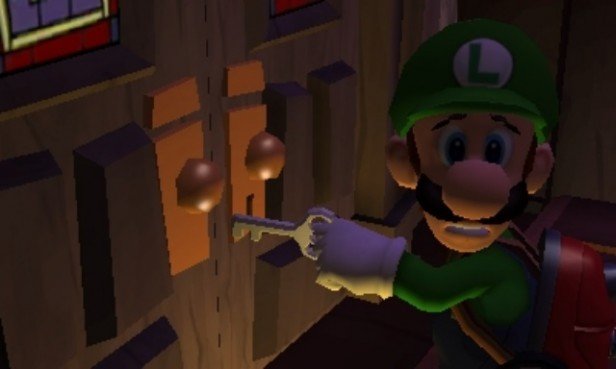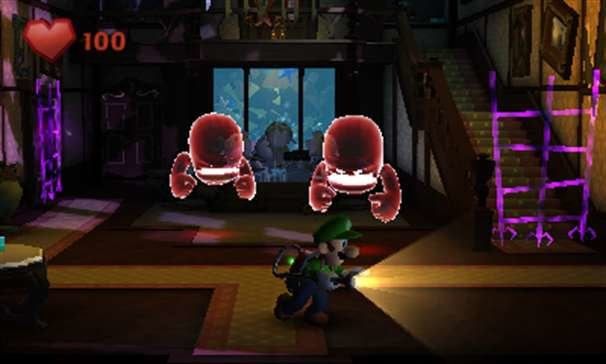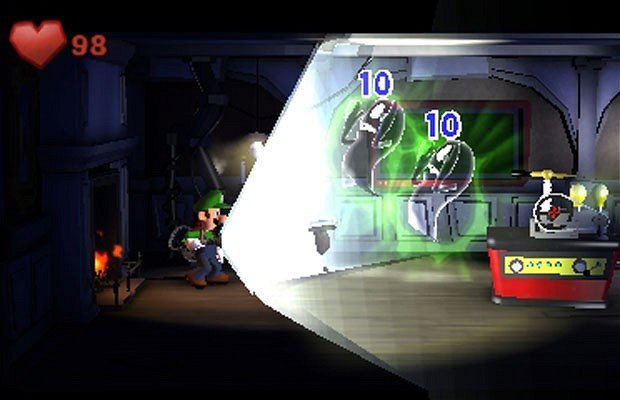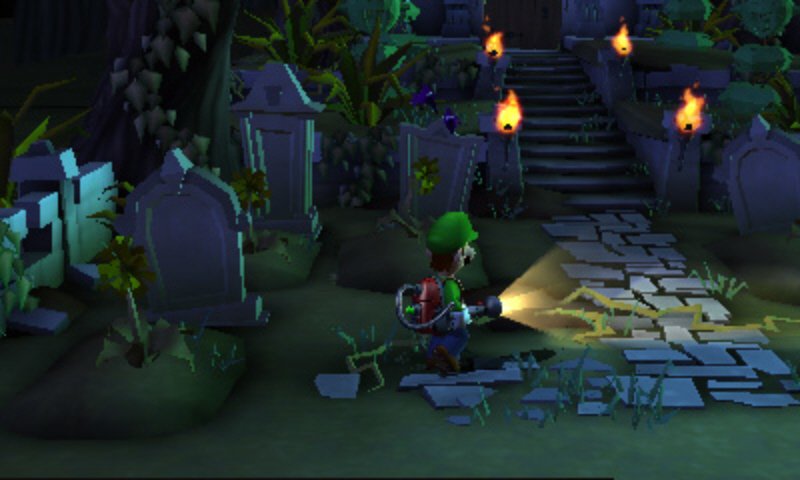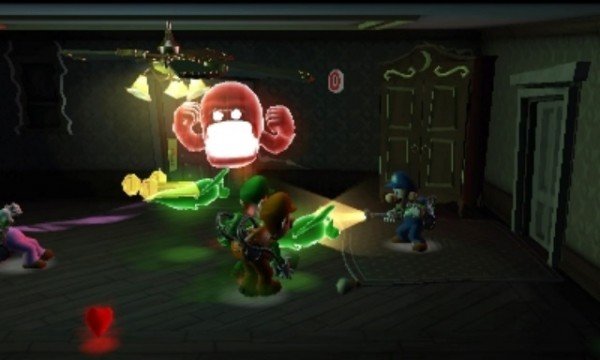Nintendo has dubbed 2013 the year of Luigi, and on the evidence of Luigi’s Mansion 2 (Luigi’s Mansion: Dark Moon in the US), they may just have a point. The easy (and admittedly, lazy) way to sum up this sequel is to say that Luigi’s Mansion 2 is the game that the GameCube original should have been. Back in the days of the launch of Nintendo‘s purple box, Luigi’s Mansion was an intriguing concept that simply wasn’t explored fully. It reeked of a game shoved out the door to hit a deadline. But thankfully, Nintendo has taken the nucleus of that title and from it, created a fully-fledged 15-20 hour adventure which proves to be one of Mario’s younger sibling’s finest moments.
Unsurprisingly for a first-party Nintendo game, Luigi’s Mansion 2‘s plot is a relatively simple one. Evershade Valley, the game’s setting, is protected by the Dark Moon, which hangs in the sky and keeps all the local ghosts and ghouls in check. But when said moon shatters and the pieces conveniently scatter into several different mansions across the land, the ghosts start to run amok. Thankfully, the returning Professor E. Gadd, who resides in Evershade Valley to continue his spectral studies, knows who to call when there’s something strange in his neighbourhood: Ghostb… I mean Luigi… And thus begins the green-capped plumber’s quest to reform the Dark Moon and save the day.
And so the narrative is perfectly functional, but hardly about to win any literary prizes. When it comes to characters though, well, let’s just say that’s a different story altogether. This is surely Luigi’s most successful outing to date when it comes to the portrayal of his personality. He’s a total wimp, in an endearing, teeth-chattering, knee-shaking kind of way, and all manner of slapstick mishap befalls him throughout his adventure. E. Gadd is just as comically mischievous and oblivious as in the original. Even the ghosts themselves are infused with a charming sense of playfulness, as they enjoy nothing more than scaring the bejesus out of poor Luigi at every opportunity.
But the meat of any Nintendo game is always the gameplay, and it’s here that Luigi’s Mansion 2 shines bright like a torch piercing through the eerie darkness. The core mechanics from the GameCube original still remain, but have been expanded upon. You’ll spend most of your time solving puzzles, exploring mansions, and, of course, hoovering up ghosts with Luigi’s trusty Poltergust 5000. The puzzles are fiendishly clever, without ever becoming overly taxing. There’s a nice variety to keep things fresh, which is impressive, given that you’d imagine there isn’t exactly an endless supply of vacuum cleaner-based puzzles to be called upon. The mansion count has gone up from one in the first game to an impressive five this time around, each with a different theme. Although each is smaller than the original’s mansion, they’re more densely populated, which means that you’ll never get too used to the same surroundings before moving onto somewhere new. The mansions are also packed to bursting with secrets and collectibles to be found: from stashes of treasure that can be used to upgrade your Poltergust, to Boos hidden behind cunning little puzzles.
The combat has seen a slight shift in focus in the transition to 3DS. You’ll be faced with rooms containing several basic ghosts emerging from every nook and cranny, rather than just one or two. And it’s a simpler affair now; rather than having to overcome puzzles every time before you can actually capture a ghost (as seen in the original), the focus is instead placed upon the combat itself. The basic premise is: find ghost, stun ghost, capture ghost. There’s some nice variations, though, like enemies armed with items such as sunglasses or buckets over their heads that must be removed before they can be stunned. Different sorts of ghosts provide slightly different challenges, but the method of attack remains the same. But it’s testament to the satisfyingly enjoyable nature of this combat that it never grows tedious, even after 15 hours. The Poltergust comes with a couple of attachments too, namely the Strobulb, which is used to stun ghosts and open safes, and the Dark Light device, which our Italian hero uses to uncover hidden items such as doors and chests. Boss battles at the end of every mansion help to mix things up even further, and for the most part, they’re excellent additions, even if a couple of them can occasionally feel a little cheap and frustrating.
It’s here that we come to the biggest issue with Luigi’s Mansion 2: the baffling lack of any checkpoints in levels whatsoever. Nintendo has made commendable efforts to cater the level structure for the gamer-on-the-go, offering four to six self-contained missions per mansion. But each level can last anything from 15 to 30 minutes (potentially longer if, like me, you choose to thoroughly explore your surroundings) and if you happen to die, the only way you can continue is if you were fortunate enough to find a health-gauge-refilling gold bone earlier in the level. These are well-hidden however, and there’s only one to be found per mission (they don’t carry over to the next stage, either). Whilst the low difficulty of the early stages of the game may make this issue seem insignificant, it will eventually, and inevitably, rear its ugly head as the enemy count and strength rises. It leaves you in the horrid position of potentially dying during an end of level boss fight and having to retrace 40 minutes of progress. All in all, it just seems a shockingly poor decision on Nintendo‘s part, and one that threatens to impose on your enjoyment of the game at times.
And whilst we’re on a negative tone, it’s worth mentioning a couple of other minor niggles with the game. Firstly, there are a couple of levels in which you’ll have the “pleasure” of being greeted by the Polterpup: a little ghostly puppy who may initially appear cute and playful, but will eventually become an annoyance who will provoke a roll of the eyes whenever he shows up. You see, the Polterpup has a nasty habit of stealing an item that is vital to the mission at hand and forcing you to chase him across the mansion to get it back. These levels just scream “filler” and don’t really bring anything original to the party at all. Another misstep from Nintendo is the inclusion of security photos, one per mansion, which must be studied for clues in between missions. These boil down to nothing more than gimmicky attempts to shoehorn in an opportunity to show off the 3D effect and gyroscope (you can tilt the system to analyse the photos). These issues may be tiny in the grand scheme of things, but they stand out when the rest of the action is of such a high standard.
But we’ll now move on to the absolute best aspect of Luigi’s Mansion 2: its simply stellar presentation. I’ll start off by saying that I played the game almost exclusively with the 3D effect turned off, but it didn’t detract from the experience at all. The graphics are nothing short of breathtaking, easily comparable to anything on Wii. There’s such a wonderfully chunky feel to all the character models, and even in the gloomy mansion settings, there’s a truly vibrant color palette on show. The animation too, of both Luigi and the ghosts, is simply top-notch and really helps to portray the excellent characterization mentioned earlier. Then there’s the sound design: again, it really does put the competition to shame. The soundtrack perfectly fits the themes, with classically spooky and eerie tunes really adding to the atmosphere. But that’s all topped by Luigi himself; the infamous Charles Martinet provides possibly his best work yet with Luigi’s vocals, and when you hear him nervously humming along to the background music, you realize that Nintendo really put in the extra effort in the presentation department, and it only adds to the quality of the overall experience.
A couple of months before release, Nintendo unveiled an unexpected multiplayer mode for Luigi’s Mansion 2. This takes the form of Thrill Tower (or Scarescraper in the US), in which up to four players team up as different-colored Luigis to work their way through the floors of the tower. There’s a few different modes, but they mostly boil down to running around manically trying to complete the specified objective in as little time as possible. It’s all good-natured fun to enjoy with friends (there’s even a single-cartridge download function so you can play with buddies who don’t own the game), but ultimately, it’s the single-player story where the main appeal of Luigi’s Mansion 2 lies.
So, when all is said and done, what we’re left with is one of the 3DS‘s very best titles, sitting alongside Super Mario 3D Land as one of the more convincing arguments as to why you should own Nintendo‘s latest handheld. There may be one or two niggles along the way; the omission P really is absolutely ludicrous, but Luigi’s Mansion 2 offers plenty of top quality bang for your buck. A nice, lengthy main story mode rights the wrongs of the short-lived original, and the mix of clever puzzles, satisfying combat, and an infectious sense of old-school humour really makes every minute spent in Luigi’s company a joy. And on this form, Nintendo really may be onto something when they call 2013 the year of Luigi. Their main man Mario better watch out, because his young upstart of a brother seems intent on taking his throne for himself…
This review is based upon a retail copy of Luigi’s Mansion 2, available exclusively for the 3DS. Developed and published by Nintendo.
- Lengthy Main Story Mode
- Great Presentation
- Excellent Graphics
- Lack of a Proper Checkpoint System

